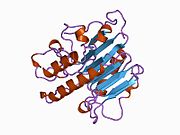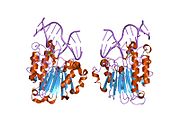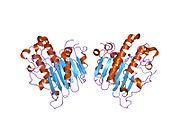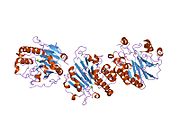APEX1
DNA-(apurinic or apyrimidinic site) lyase is an enzyme that in humans is encoded by the APEX1 gene.
Apurinic/apyrimidinic (AP) sites (also called "abasic sites") occur frequently in DNA molecules by spontaneous hydrolysis, by DNA damaging agents or by DNA glycosylases that remove specific abnormal bases. AP sites are pre-mutagenic lesions that can prevent normal DNA replication. All cells, from simple prokaryotes to humans, have evolved systems to identify and repair such sites. Class II AP endonucleases cleave the phosphodiester backbone 5' to the AP site, thereby initiating a process known as base excision repair (BER). The APEX gene (alternatively named APE1, HAP1, APEN) encodes the major AP endonuclease in human cells. Splice variants have been found for this gene; all encode the same protein.[5]
Interactions
APEX1 has been shown to interact with MUTYH,[6] Flap structure-specific endonuclease 1[7] and XRCC1.[8]
References
- ^ a b c GRCh38: Ensembl release 89: ENSG00000100823 – Ensembl, May 2017
- ^ a b c GRCm38: Ensembl release 89: ENSMUSG00000035960 – Ensembl, May 2017
- ^ "Human PubMed Reference:". National Center for Biotechnology Information, U.S. National Library of Medicine.
- ^ "Mouse PubMed Reference:". National Center for Biotechnology Information, U.S. National Library of Medicine.
- ^ "Entrez Gene: APEX1 APEX nuclease (multifunctional DNA repair enzyme) 1".
- ^ Parker A, Gu Y, Mahoney W, Lee SH, Singh KK, Lu AL (February 2001). "Human homolog of the MutY repair protein (hMYH) physically interacts with proteins involved in long patch DNA base excision repair". The Journal of Biological Chemistry. 276 (8): 5547–55. doi:10.1074/jbc.M008463200. PMID 11092888.
- ^ Dianova II, Bohr VA, Dianov GL (October 2001). "Interaction of human AP endonuclease 1 with flap endonuclease 1 and proliferating cell nuclear antigen involved in long-patch base excision repair". Biochemistry. 40 (42): 12639–44. doi:10.1021/bi011117i. PMID 11601988.
- ^ Vidal AE, Boiteux S, Hickson ID, Radicella JP (November 2001). "XRCC1 coordinates the initial and late stages of DNA abasic site repair through protein-protein interactions". The EMBO Journal. 20 (22): 6530–9. doi:10.1093/emboj/20.22.6530. PMC 125722. PMID 11707423.
Further reading
- Mol CD, Hosfield DJ, Tainer JA (August 2000). "Abasic site recognition by two apurinic/apyrimidinic endonuclease families in DNA base excision repair: the 3' ends justify the means". Mutation Research. 460 (3–4): 211–29. doi:10.1016/s0921-8777(00)00028-8. PMID 10946230.
- Fritz G (September 2000). "Human APE/Ref-1 protein". The International Journal of Biochemistry & Cell Biology. 32 (9): 925–9. doi:10.1016/S1357-2725(00)00045-5. PMID 11084372.
- Fritz G, Grösch S, Tomicic M, Kaina B (November 2003). "APE/Ref-1 and the mammalian response to genotoxic stress". Toxicology. 193 (1–2): 67–78. doi:10.1016/S0300-483X(03)00290-7. PMID 14599768.
- Tell G, Damante G, Caldwell D, Kelley MR (2005). "The intracellular localization of APE1/Ref-1: more than a passive phenomenon?". Antioxidants & Redox Signaling. 7 (3–4): 367–84. doi:10.1089/ars.2005.7.367. hdl:1805/4802. PMID 15706084.
- Hung RJ, Hall J, Brennan P, Boffetta P (November 2005). "Genetic polymorphisms in the base excision repair pathway and cancer risk: a HuGE review". American Journal of Epidemiology. 162 (10): 925–42. doi:10.1093/aje/kwi318. PMID 16221808.
- Dyrkheeva NS, Khodyreva SN, Lavrik OI (2007). "[Multifunctional human apurinic/apyrimidinic endonuclease 1: the role of additional functions]". Molekuliarnaia Biologiia. 41 (3): 450–66. PMID 17685223.
- Harrison L, Ascione G, Menninger JC, Ward DC, Demple B (December 1992). "Human apurinic endonuclease gene (APE): structure and genomic mapping (chromosome 14q11.2-12)". Human Molecular Genetics. 1 (9): 677–80. doi:10.1093/hmg/1.9.677. PMID 1284593.
- Cheng XB, Bunville J, Patterson TA (January 1992). "Nucleotide sequence of a cDNA for an apurinic/apyrimidinic endonuclease from HeLa cells". Nucleic Acids Research. 20 (2): 370. doi:10.1093/nar/20.2.370. PMC 310384. PMID 1371347.
- Xanthoudakis S, Miao G, Wang F, Pan YC, Curran T (September 1992). "Redox activation of Fos-Jun DNA binding activity is mediated by a DNA repair enzyme". The EMBO Journal. 11 (9): 3323–35. doi:10.1002/j.1460-2075.1992.tb05411.x. PMC 556867. PMID 1380454.
- Zhao B, Grandy DK, Hagerup JM, Magenis RE, Smith L, Chauhan BC, Henner WD (August 1992). "The human gene for apurinic/apyrimidinic endonuclease (HAP1): sequence and localization to chromosome 14 band q12". Nucleic Acids Research. 20 (15): 4097–8. doi:10.1093/nar/20.15.4097. PMC 334100. PMID 1380694.
- Robson CN, Hochhauser D, Craig R, Rack K, Buckle VJ, Hickson ID (September 1992). "Structure of the human DNA repair gene HAP1 and its localisation to chromosome 14q 11.2-12". Nucleic Acids Research. 20 (17): 4417–21. doi:10.1093/nar/20.17.4417. PMC 334166. PMID 1383925.
- Seki S, Hatsushika M, Watanabe S, Akiyama K, Nagao K, Tsutsui K (July 1992). "cDNA cloning, sequencing, expression and possible domain structure of human APEX nuclease homologous to Escherichia coli exonuclease III". Biochimica et Biophysica Acta (BBA) - Gene Structure and Expression. 1131 (3): 287–99. doi:10.1016/0167-4781(92)90027-w. PMID 1627644.
- Robson CN, Hickson ID (October 1991). "Isolation of cDNA clones encoding a human apurinic/apyrimidinic endonuclease that corrects DNA repair and mutagenesis defects in E. coli xth (exonuclease III) mutants". Nucleic Acids Research. 19 (20): 5519–23. doi:10.1093/nar/19.20.5519. PMC 328951. PMID 1719477.
- Demple B, Herman T, Chen DS (December 1991). "Cloning and expression of APE, the cDNA encoding the major human apurinic endonuclease: definition of a family of DNA repair enzymes". Proceedings of the National Academy of Sciences of the United States of America. 88 (24): 11450–4. Bibcode:1991PNAS...8811450D. doi:10.1073/pnas.88.24.11450. PMC 53153. PMID 1722334.
- Okazaki T, Chung U, Nishishita T, Ebisu S, Usuda S, Mishiro S, Xanthoudakis S, Igarashi T, Ogata E (November 1994). "A redox factor protein, ref1, is involved in negative gene regulation by extracellular calcium". The Journal of Biological Chemistry. 269 (45): 27855–62. PMID 7961715.
- Akiyama K, Seki S, Oshida T, Yoshida MC (September 1994). "Structure, promoter analysis and chromosomal assignment of the human APEX gene". Biochimica et Biophysica Acta (BBA) - Gene Structure and Expression. 1219 (1): 15–25. doi:10.1016/0167-4781(94)90241-0. PMID 8086453.
- Andersson B, Wentland MA, Ricafrente JY, Liu W, Gibbs RA (April 1996). "A "double adaptor" method for improved shotgun library construction". Analytical Biochemistry. 236 (1): 107–13. doi:10.1006/abio.1996.0138. PMID 8619474.
- Chung U, Igarashi T, Nishishita T, Iwanari H, Iwamatsu A, Suwa A, Mimori T, Hata K, Ebisu S, Ogata E, Fujita T, Okazaki T (April 1996). "The interaction between Ku antigen and REF1 protein mediates negative gene regulation by extracellular calcium". The Journal of Biological Chemistry. 271 (15): 8593–8. doi:10.1074/jbc.271.15.8593. PMID 8621488.
- Rothwell DG, Hickson ID (November 1996). "Asparagine 212 is essential for abasic site recognition by the human DNA repair endonuclease HAP1". Nucleic Acids Research. 24 (21): 4217–21. doi:10.1093/nar/24.21.4217. PMC 146231. PMID 8932375.
- Izumi T, Henner WD, Mitra S (November 1996). "Negative regulation of the major human AP-endonuclease, a multifunctional protein". Biochemistry. 35 (47): 14679–83. doi:10.1021/bi961995u. PMID 8942627.
External links
- Human APEX1 genome location and APEX1 gene details page in the UCSC Genome Browser.













